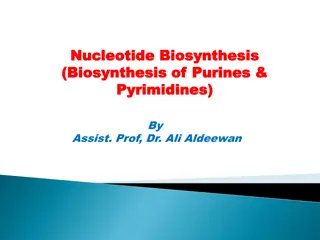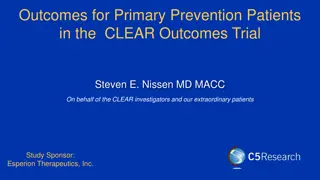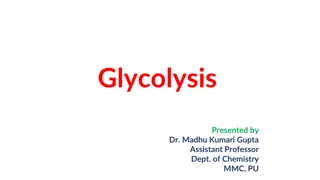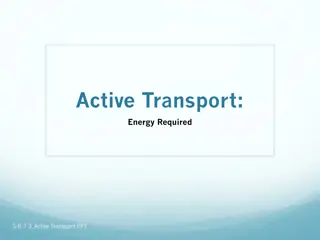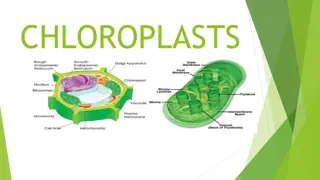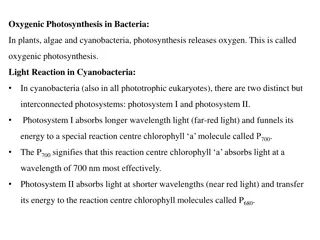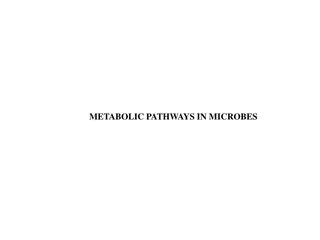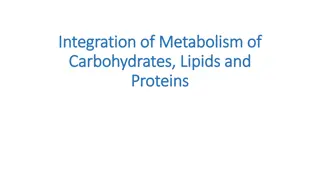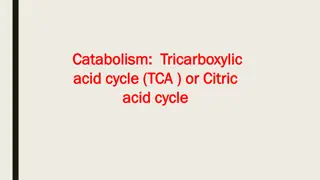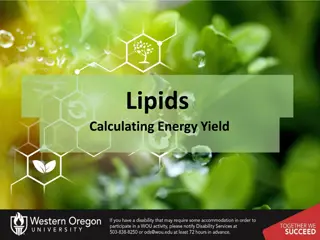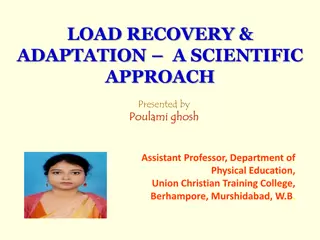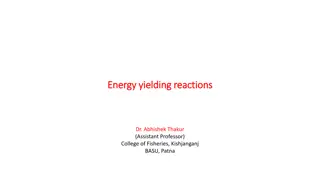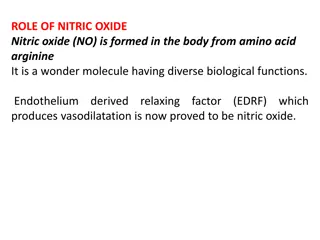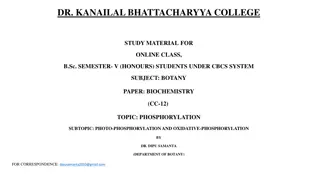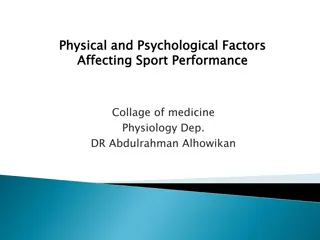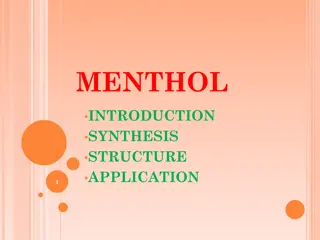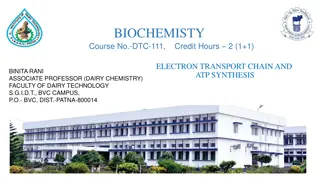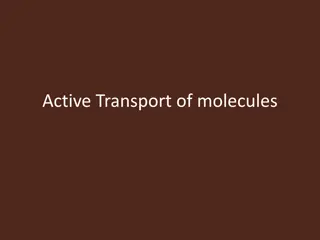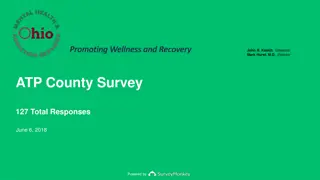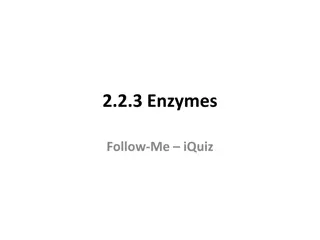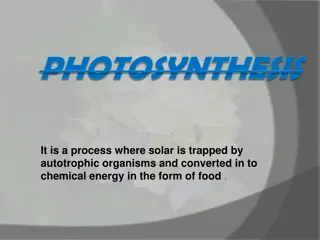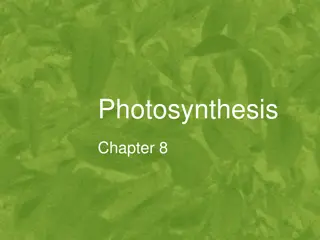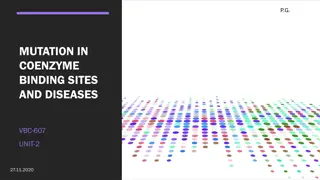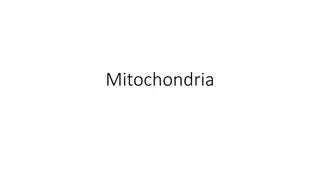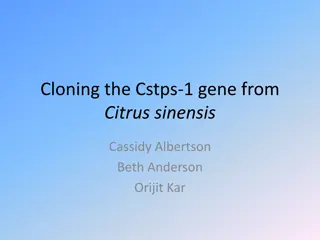Ethanol production
Ethanol, produced through fermentation by yeast in oxygen-free conditions, serves as a chemical feedstock, solvent, disinfectant, and fuel additive. The biochemistry involves sugar breakdown to pyruvic acid, then conversion to acetaldehyde and finally ethanol. Yeast growth in rich medium leads to et
0 views • 21 slides
Enhancing TLB Prefetching for Address Translation Performance
This study explores methods to improve TLB prefetching efficiency by leveraging page table locality, presenting two novel approaches - Sampling-based Free TLB Prefetching (SBFP) and Agile TLB Prefetcher (ATP). These techniques focus on optimizing TLB prefetching mechanisms without disrupting the vir
1 views • 10 slides
Understanding Cell Viability Assays in Laboratory Testing
Cell viability assays play a crucial role in determining the health and status of cells, measuring their ability to survive and proliferate. These assays involve various techniques such as dye exclusion, colorimetric, fluorometric, luminometric, and flow cytometric assays. By assessing factors like
6 views • 16 slides
Understanding Motor Proteins and Cytoskeletal Dynamics in Cell Biology
Motor proteins, such as myosin, kinesin, and dynein, utilize chemical energy to move along cellular tracks, influencing processes like muscle contraction, organelle movements, and cellular migration. With the ability to translocate using ATP hydrolysis, these proteins play crucial roles in various c
5 views • 14 slides
Caltrans District 12 Local Assistance Update - March 27, 2024
The Caltrans District 12 Local Assistance Update for March 27, 2024, provides important information on various topics such as CTC Meetings deadlines, Inactive Invoices submission, Active Transportation Program (ATP) updates, and Highway Safety Improvement Program (HSIP) details. Stay informed about
0 views • 13 slides
Understanding Nucleotide Biosynthesis and Nucleic Acids
Exploring the biosynthesis of purines and pyrimidines, essential components for DNA and RNA structures. Delve into the world of pyrimidines, purines, nucleosides, nucleotides, and adenosine derivatives like AMP, ADP, ATP, and cAMP, crucial for various biological processes. Unravel the significance o
5 views • 44 slides
CLEAR Outcomes Trial: Bempedoic Acid for Cardiovascular Prevention
The CLEAR Outcomes Trial investigated the effects of bempedoic acid, an ATP citrate lyase inhibitor, on cardiovascular outcomes in primary prevention patients. Results showed a reduction in cardiovascular events with bempedoic acid, particularly in patients intolerant to statins. Baseline characteri
0 views • 13 slides
Regulation of Energy Homeostasis by AMPK System and Its Modulation Factors
The AMPK system plays a crucial role in regulating energy homeostasis by sensing the cellular AMP:ATP ratio and responding to metabolic stresses that affect ATP production or consumption. AMPK is activated by factors such as hypoxia, glucose deprivation, and metabolic inhibitors, as well as by compo
0 views • 27 slides
Understanding Cellular Respiration and Metabolism in Living Organisms
Cellular respiration is a vital process in all living cells, producing energy through chemical reactions. Metabolism, consisting of anabolism and catabolism, maintains growth and function. ATP plays a central role as energy currency in cells. Through stages like glycolysis and the Krebs cycle, cellu
0 views • 16 slides
Understanding Glycolysis: The Initial Step in Glucose Breakdown
Glycolysis, presented by Dr. Madhu Kumari Gupta, is a crucial process in cellular metabolism that involves the breakdown of glucose to extract energy. This pathway occurs in the cytosol and consists of three main phases - an energy-requiring phase, a splitting phase, and an energy-releasing phase. T
0 views • 12 slides
Understanding Cellular Respiration and Oxygen Delivery
Cellular respiration, a vital process for organ survival, involves mitochondria performing cellular respiration by utilizing glucose and oxygen. Glucose is derived from diet or body breakdown, while oxygen enters through the respiratory system, facilitated by red blood cells in the circulatory syste
0 views • 8 slides
Understanding Active Transport: Energy-Driven Cellular Processes
Active transport is a vital process in cells that require energy in the form of ATP to move materials across the plasma membrane against their concentration gradient. This process involves pumps, endocytosis, and exocytosis. The sodium-potassium pump in nerve cells is a classic example of active tra
0 views • 9 slides
Understanding Muscle Contraction: Sliding Filament Theory and Cross Bridge Cycle
Explore the fascinating process of muscle contraction through the sliding filament theory and cross bridge cycle. Developed by scientists in 1954, this mechanism involves the interaction between myosin and actin filaments, regulated by calcium and ATP. The cycle includes steps such as myosin binding
0 views • 11 slides
Understanding Bacterial Photosynthesis: Types and Processes
Photosynthesis is the conversion of light energy into chemical energy, crucial for growth and production of ATP. Prokaryotes such as cyanobacteria, purple and green bacteria, and halobacteria demonstrate different forms of photosynthesis. Oxygenic photosynthesis, found in cyanobacteria, releases oxy
2 views • 20 slides
Understanding Chloroplasts: Structure, Function, and Marker Enzymes
Chloroplasts are vital organelles in plant cells responsible for photosynthesis, converting light energy into chemical energy. They contain chlorophyll pigments for light absorption and play a crucial role in synthesizing foodstuffs. Marker enzymes such as RUBISCO, NADP-Reductase, and ATP synthase a
1 views • 7 slides
Understanding Photosynthesis in Bacteria and Cyanobacteria
Oxygenic photosynthesis in plants, algae, and cyanobacteria releases oxygen. Cyanobacteria utilize photosystems I and II in their light reactions, with distinct roles in light absorption and electron transfer. Cyclic photophosphorylation involves only photosystem I, while non-cyclic photophosphoryla
0 views • 10 slides
Understanding Metabolic Pathways in Microbes
Metabolism in living organisms involves anabolism and catabolism, where anabolism generates essential biomolecules for growth using energy, while catabolism breaks down nutrients for energy release. Anabolic processes include synthesis of carbohydrates, lipids, proteins, nucleic acids, and other gro
7 views • 24 slides
Understanding the Integration of Carbohydrate, Lipid, and Protein Metabolism
The integration of metabolism involving carbohydrates, lipids, and proteins can be divided into three stages: hydrolysis to simpler units, preparatory stage, and oxidative stage. In the hydrolysis stage, complex polysaccharides, lipids, and proteins are broken down to simpler forms. The preparatory
2 views • 13 slides
Overview of Cellular Respiration Pathways and ATP Generation
Cellular respiration involves key processes like the Tricarboxylic Acid Cycle (TCA), Electron Transport Chain, and ATP generation pathways. The TCA cycle utilizes Acetyl-CoA to produce energy-rich molecules, while the Electron Transport Chain facilitates ATP synthesis through oxidative phosphorylati
0 views • 18 slides
Energy Yield from Lipid Oxidation Process
Understanding the energy generation process from lipid oxidation involves the conversion of fatty acids into Acetyl-CoA through multiple rounds of oxidation, which then enter the Krebs cycle to produce ATP. Each round of oxidation results in the production of Acetyl-CoA, NADH, FADH2, and net gains o
0 views • 7 slides
Understanding Load, Recovery, and Adaptation in Training
Load, recovery, and adaptation in training are crucial for improving performance. Training load indicates the intensity of a session and the required recovery time. Fatigue is a common outcome of intense exercise, impacting performance. Energy supply and factors like phosphocreatine availability inf
4 views • 24 slides
Understanding the Electron Transport Chain in Bacteria
The electron transport chain in bacteria plays a crucial role in generating additional ATP by oxidative phosphorylation. It involves the transfer of electrons from NADH and FADH2 to oxygen through a series of membrane-associated electron carriers. The chemiosmotic theory explains how this process fu
4 views • 10 slides
Understanding Energy-Yielding Reactions in Biological Systems
Energy-yielding reactions play a crucial role in producing energy for cellular processes. Dr. Abhishek Thakur explains oxidation-reduction, substrate-level phosphorylation, oxidative phosphorylation, photophosphorylation, and biochemical pathways of energy production. These reactions involve electro
1 views • 21 slides
Amino Acid Absorption Mechanisms in Small Intestine
Amino acid absorption in the small intestine is an active process requiring energy derived from ATP hydrolysis. It involves two main mechanisms: carrier proteins transport system and glutathione transport system. The carrier proteins transport system uses ATP energy for absorption, while glutathione
0 views • 18 slides
Role of Nitric Oxide in the Body: Functions, Formation, and Clinical Aspects
Nitric oxide (NO), a vital molecule formed from arginine, plays diverse roles in the body including vasodilation, neurotransmission, platelet regulation, and immune response. Its formation involves a complex enzyme called nitrogen oxide synthase. Various inhibitors and clinical implications, such as
0 views • 19 slides
Understanding Photophosphorylation and Oxidative Phosphorylation in Biochemistry
Phosphorylation is the process of ATP production from ADP, occurring in two main forms - Photophosphorylation and Oxidative Phosphorylation. Photophosphorylation involves utilizing light energy to convert ADP to ATP, with two types: Cyclic and Non-Cyclic. Oxidative Phosphorylation uses energy from t
0 views • 15 slides
Understanding Physical and Psychological Factors in Sports Performance
This lecture covers important aspects of sport performance, including muscle metabolic systems, recovery processes, nutrients used during activity, effects of smoking and heart disease on performance, body fluids and salt balance, and the impact of drugs on athletes. Topics discussed include ATP ene
0 views • 23 slides
Menthol: Synthesis, Structure, and Applications
Menthol is an organic compound found in mint oils, synthesized or derived from cornmint or peppermint. It has a waxy, crystalline form and is solid at room temperature. The biosynthesis of menthol involves several enzymatic steps starting from the terpene limonene. Various enzymes such as geranyl di
0 views • 12 slides
Understanding Electron Transport Chain and ATP Synthesis in Biochemistry
This course delves into the intricacies of electron transport and oxidative phosphorylation in biochemistry, elucidating how NADH and FADH2 are re-oxidized to generate ATP in eukaryotes and prokaryotes. It explores redox potential, oxidation-reduction reactions, and the role of standard redox potent
0 views • 20 slides
Understanding Active Transport of Molecules: Driven by ATP Hydrolysis
Active transport, fueled by ATP hydrolysis, facilitates the movement of molecules against their concentration gradients, essential for processes like ion pumping across membranes. The Na+-K+ pump, a prime example, utilizes ATP to transport Na+ and K+ ions across cellular membranes, maintaining impor
0 views • 23 slides
Promoting Wellness and Recovery ATP County Survey Results
Survey conducted on June 6, 2018, with 127 total responses representing various counties. Participants reported on entities represented, counties served, behavioral health services, recovery supports provided, obstacles in accessing ATP services for clients, and more. Illustrative images provided fo
0 views • 11 slides
Accelerate Your Aviation Career with ATP-CTP Course Available at Top Schools
Las Vegas Flight Academy has a specialty programme referred to as the ATP-CTP Course Available programme that can help get you directly to the cockpit seat of an airline transport aircraft as quickly as possible. The highest quality instructors and a
0 views • 5 slides
Acquisition, Tracking, and Pointing (ATP) for NG-OWC System in Drone Networks
The research discusses the implementation of Acquisition, Tracking, and Pointing (ATP) in Next-Generation Optical Wireless Communication (NG-OWC) systems for drone networks. It covers the background of drone networks, ATP overview, schemes, tracking mechanism, current developments, challenges, and c
0 views • 16 slides
Understanding Metabolism: Enzymes and ATP
Explore the concept of metabolism through the roles of enzymes and ATP. Learn about chemical reactions in living cells, substrate interactions, and the essential functions of Adenosine Triphosphate. Test your knowledge with interactive quizzes and uncover the key principles governing cellular proces
0 views • 50 slides
Understanding Cellular Respiration: Energy Production in Organisms
Organisms can be classified into autotrophs that use sunlight for photosynthesis and heterotrophs that rely on consuming food. Regardless of food source, all organisms obtain energy through cellular respiration, a process that converts stored chemical energy into ATP. This energy currency is essenti
0 views • 21 slides
Understanding Photosynthesis and Photophosphorylation Processes
Photosynthesis is a vital process where autotrophic organisms trap solar energy to convert it into chemical energy in the form of food. Non-cyclic photophosphorylation involves the transfer of phosphate groups and ATP synthesis utilizing light energy. This process takes place at photosystem II in ch
0 views • 10 slides
Understanding Energy and Photosynthesis in Living Organisms
This content delves into the fundamental concepts of energy in living organisms, exploring topics such as the role of ATP as a chemical fuel, energy storage and release mechanisms, the similarities and differences between ATP and glucose, and the energy sourcing processes of heterotrophs and autotro
0 views • 29 slides
Mutations in Coenzyme Binding Sites and Related Diseases
Mutations in coenzyme binding sites can lead to diseases by impacting enzyme affinity and reaction rates. Defects in proteins like ornithine aminotransferase and cystathionine-synthase result in conditions such as gyrate atrophy of the choroid and retina, homocystinuria, and X-linked sideroblastic a
0 views • 14 slides
Understanding the Structure and Function of Mitochondria
Mitochondria, derived from Greek words meaning thread and granule, are essential organelles found in eukaryotic cells. They serve as energy powerhouses, metabolizing carbohydrates and fatty acids to produce adenosine triphosphate (ATP). The inner and outer membranes of mitochondria contain proteins
0 views • 14 slides
Cloning the Cstps-1 Gene from Citrus sinensis for Valencene Production
In this project, the Cstps-1 gene from Citrus sinensis is being cloned to produce the enzyme Citrus Valencene Synthase (CVS) responsible for generating the fragrant valencene compound. The process involves DNA isolation from a Valencia orange, gene amplification, vector transformation, and testing f
0 views • 8 slides





